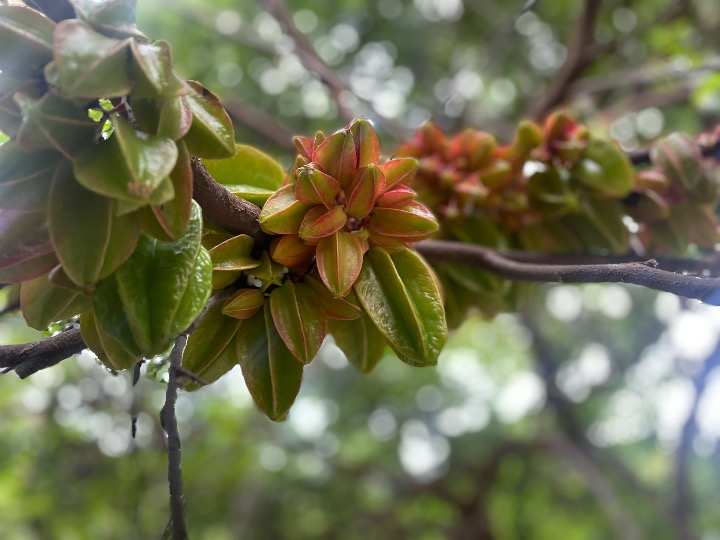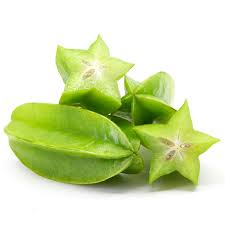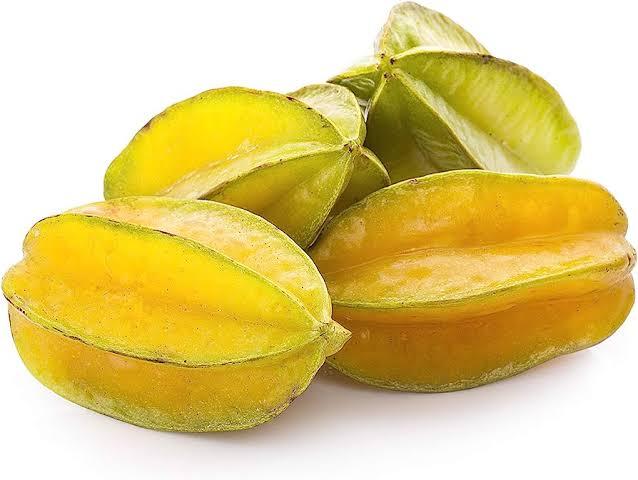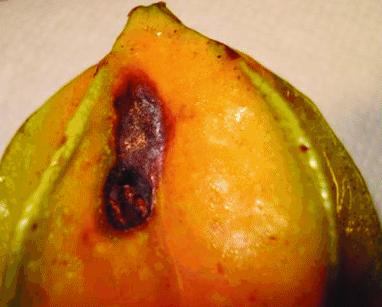Star fruit(స్టార్ ఫ్రూట్) Plant
Star Fruit, also known as Averrhoa carambola, is an outdoor fruiting tree. Plant in well-draining soil with full sun exposure. Water consistently, especially during dry periods. Pruning can be done to shape the tree and remove dead or crowded branches. Fertilize during the growing season.
Habit
Tree
Height
5-10 m
Growth
Fast
Soil
Well Drained, loamy
Shade
Full Sun
Moisture
Moist
Edible
Yes
Medicinal
No
Origin
Southeast Asia
Climatic Condition
Tropical, Subtropical
Temperature (°)
25-30°C
Humidity (%)
60-80%
Potting media
Loamy, peat
Fertilizers
Balanced NPK
Watering
Regular
Plant Weight
500-700 g
Flowering Time
Summer, Fall
Soil Ph level
5.5 - 6.5
Water Ph level
6.0 - 7.0
Soil EC
1-2 dS/m
Yield Per Plant
200 - 500 kg/tree
NPK ratio
10:10:10
life Span
Perennial
Health Benefits
Vitamin C-rich, anti-inflammatory
Suggested Grow Media or Potting Mix ?
50% loam, 25% compost, 25% sand
Suggested Fertigation/Fertilizers
Fertilize every 6 weeks with a balanced fertilizer.
Common Diseases and Remedies
Alternaria black spot , anthracnose
Small, circular light brown or black spots on skin of fruits; lesions develop sunken centres and olive-brown spores.
destroying the infected plant
HEALTH BENEFITS
· High in vitamin C, fiber, and antioxidants.
· Supports heart health by reducing cholesterol.
· Aids digestion and boosts immunity.
· Helps manage blood sugar levels.
What Is An Star Fruit(స్టార్ ఫ్రూట్) Tree?
Star fruit, also known as star fruit, is a tropical fruit from Southeast Asia. It grows on small green trees and is distinguished by its star-shaped cross-section when cut. Star fruit crops need warm weather, well-drained soil and regular rainfall. They are sensitive to frost and do best in areas where temperatures are above 15°C (60°F). Star fruit trees usually bear fruit within 3 to 5 years of planting and can bear fruit for many years. The fruit is rich in vitamin C and antioxidants and has a sweet and tangy taste. It is used in many kinds of dishes, fruit juices and desserts. Proper care, including pruning, watering and pesticides, is essential for good growth and yield of your star fruit crop.

What Are The Different Types Of Star Fruit(స్టార్ ఫ్రూట్) Plants?
1. Golden star fruit (స్టార్ ఫ్రూట్)(Averroa carambola)
This is the most common type and is characterized by its yellow color when ripe.
2. Green carambola (Averroa carambola):
This variety remains green even after ripening and is slightly larger than the golden variety.
3. Oxalis star fruit (స్టార్ ఫ్రూట్)(Averroa bilgibi):
This species is smaller and more tart than star fruit. It is often used in cooking and pickling.
4. Hawaiian star fruit(స్టార్ ఫ్రూట్) (Averroa moluccensis)
Native to Hawaii, much smaller and sweeter than the golden star.

How to care for Star Fruit(స్టార్ ఫ్రూట్) Plants ?
Plant star fruit in full sun, away from other trees, buildings, structures and power lines. Besides warmth, these plants need well-drained soil, improved fertilization and protection from wind. Supplemental watering may also be needed as star fruit is not drought tolerant.
1. Location
The star fruit tree, also known as the carambola tree, is native to Southeast Asia but is now grown in tropical and subtropical regions worldwide. They thrive in warm weather, well-drained soil and full sun. That's why you'll find them in Southeast Asia, South America, the Caribbean, and parts of the United States like Florida and Hawaii. Star fruit, also known as Carambola, is often grown outdoors in warm climates. It needs a sunny and warm tropical or subtropical environment to thrive. However, it can grow indoors in a container such as a greenhouse as long as it receives sufficient light and temperature in cold weather.
2. Sunshine
It sounds like you are talking about the sun needs of your Carambola plants. Star fruit plants, also known as carambola, generally thrive in full sun, meaning they need at least 6-8 hours of direct sunlight per day to grow and produce fruit. Providing adequate sunlight is essential for healthy star fruit production and fruit development.
3. Soil
The soil where the fruit grows should be well-drained and slightly acidic, with a pH between 5.5 and 6.5. A mixture of sandy loam soil and organic matter such as compost or aged manure works well. Make sure the soil is nutrient-rich and well-aerated to support healthy root development.
4. Hydration
The soil where the fruit grows should be well-drained and slightly acidic, with a pH between 5.5 and 6.5. A mixture of sandy loam soil and organic matter such as compost or aged manure works well. Make sure the soil is nutrient-rich and well-aerated to support healthy root development.

5. Nourishment
The carambola plant, also known as carambola, usually grows as a small to medium-sized tree or shrub. Here is an overview of their development: Seedling Stage: Star fruit plants can be grown from seed, but the fruits usually take several years to develop. During this time, they settle into the soil by creating a strong root system. Development: Once established, the plant begins to produce leaves and branches. Providing adequate sunlight, water and nutrients during this period is important to promote good growth. Flower: The star fruit plant usually begins to bloom when mature, usually 3-5 years later. The flowers are small, pinkish-green and appear in clusters along the branches. Fruit development: After completion of pollination, the flower turns into a star fruit.
6. Issues
Star fruit, also known as star fruit, can experience many problems, including: Pests: Pests that affect sun fruit include aphids, fruit flies, scale insects, and mealybugs. These pests can damage leaves, flowers and fruit, reducing the overall health and productivity of plants. Diseases: Star fruit plants are susceptible to fungal diseases such as anthracnose, powdery mildew and root rot. Diseases that cause symptoms such as leaf drop, wilt and fruit rot may also occur. Environmental Stress: Carambola plants are sensitive to environmental stress such as hot weather, drought and waterlogging. These conditions weaken the plant, making it vulnerable to pests and diseases. Nutrient deficiencies: Soil deficiency causes slow growth, poor fruit development and susceptibility to diseases. Most of them lack nitrogen, potassium and magnesium.
What are the Benefits of Star Fruit(స్టార్ ఫ్రూట్) Plants ?
Star fruit is rich in vitamin C, fiber and antioxidants, which are important for overall health and immunity. Low Calorie: It is low in calories and can be a good addition to a weight loss diet. Star fruit has a high water content, which helps with hydration and supports all body function . The fiber content in star fruit can support digestion by preventing constipation and promoting digestion. Antioxidants in star fruit may help reduce the risk of heart disease by lowering cholesterol and improving blood circulation. Vitamin C in star fruit supports collagen production, promotes healthy skin

FAQs About Growing Star Fruit(స్టార్ ఫ్రూట్)
1. How do Carambola plants grow?
The carambola plant, also known as carambola, usually grows as a small to medium-sized tree or shrub. Here is an overview of their development: Seedling Stage: Star fruit plants can be grown from seed, but the fruits usually take several years to develop. During this time, they settle into the soil by creating a strong root system. Development: Once established, the plant begins to produce leaves and branches. Providing adequate sunlight, water and nutrients during this period is important to promote good growth. Flower: The star fruit plant usually begins to bloom when mature, usually 3-5 years later. The flowers are small, pinkish-green and appear in clusters along the branches. Fruit development: After completion of pollination, the flower turns into a star fruit. These fruits start out green and gradually turn yellow as they ripen.
2. What type of soil do Carambola plants like?
Star fruit plant, also known as carambola plant, prefers slightly acidic to neutral (pH 5.5 to 7.5) well-drained soil. They grow in soil that is rich in organic matter, retains water well, and is not saturated with water. Sandy loam or loam soil types are ideal for star fruit plants. They also need well-aerated soil to encourage healthy roots.
3. How much sunlight do Carambola plants need?
The star fruit plant, like many fruit trees, requires frequent sunlight to thrive. They need at least 6-8 hours of direct sunlight per day for good growth and fruit production. In hot regions, partial shade during the hottest hours of the day will help prevent plant stress.
4. What are the pests and diseases that affect Carambola plants?
Pests and diseases affecting star fruit are as follows:
Pests:
Fruit: They cause diseases in the fruit by laying eggs on the fruit. They suck water from leaves, causing them to curl and twist. Scale insect: Causes yellowing and wilting of leaves by feeding on fruit juice. Mealybugs: Produce a white, cottony material that absorbs nutrients in leaves and stems. Spider mites: They cause mottling and yellowing of leaves due to their feeding activities.
Disease:
Anthracnose: Causes dark, sunken lesions on fruits, leaves and stems. Powdery mildew: White powder forms on leaves and reduces photosynthesis. Leaf spots: Small spots appear on the leaves and cause defoliation. Root Rot: Caused by a fungal disease in very wet soil and causes plants to wilt and die. Bacterial canker: Causes dark, sunken lesions on branches and trunks that eventually lead to death.

